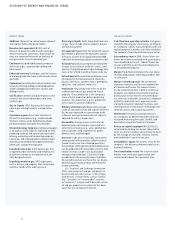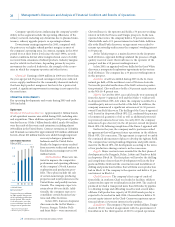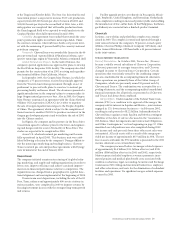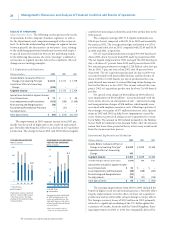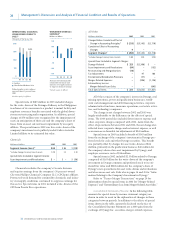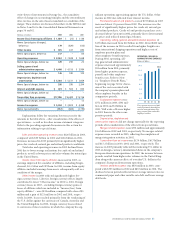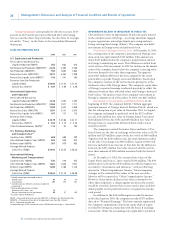Chevron 2003 Annual Report Download - page 26
Download and view the complete annual report
Please find page 26 of the 2003 Chevron annual report below. You can navigate through the pages in the report by either clicking on the pages listed below, or by using the keyword search tool below to find specific information within the annual report.
24
GLOSSARY OF ENERGY AND FINANCIAL TERMS
ENERGY TERMS
Additives Chemicals to control engine deposits
and improve lubricating performance.
Barrels of oil-equivalent (BOE) A unit of
meas ure to quantify crude oil and natural gas
amounts using the same basis. Natural gas vol-
umes are converted to barrels on the basis of
energy content. See oil-equivalent gas.
Condensates Liquid hydrocarbons pro duced
with natural gas, separated by cooling and
other means.
Enhanced recovery Techniques used to increase
or prolong production from crude oil and natural
gas fields.
Exploration Searching for crude oil and/or natu-
ral gas by utilizing geologic and topographical
studies, geophysical and seismic surveys, and
drilling of wells.
Gasifi cation Commercially proven process that
converts low-value hydrocarbons into clean
synthesis gas.
Gas-to-liquids (GTL) A process that converts
natural gas into high-quality transportation
fuels.
Greenhouse gases Gases that trap heat in
the Earth’s atmosphere (e.g., carbon dioxide,
methane, nitrous oxide, hydrofluorocarbons,
perfluorocarbons and sulfur hexafluoride).
Integrated energy company A com pany en gaged
in all aspects of the industry: exploring for and
producing crude oil and natural gas (upstream);
refi ning, marketing and transporting crude oil,
natural gas and refi ned products (downstream);
manufacturing and distributing petrochemicals
(chemicals); and generating power.
Liquefied natural gas (LNG) Natural gas that
is liquefi ed under extremely cold tem per atures
to facilitate storage or transportation in spe-
cially designed vessels.
Liquefied petroleum gas (LPG) Light gases,
such as butane and propane, that can be main-
tained as liquids while under pressure.
Natural gas liquids (NGL) Sepa rated from natu-
ral gas, these include ethane, pro pane, butane
and natural gasoline.
Oil-equivalent gas (OEG) The volume of natu ral
gas needed to generate the equivalent amount
of heat as a barrel of oil (approximately 6,000
cubic feet of natural gas equals one barrel of oil).
Oil sands Naturally occurring mixture of bitu men –
a heavy viscous form of crude oil – water, sand
and clay. Using hydroprocessing technology, bitu-
men can be refi ned to yield synthetic crude oils.
Petrochemicals Derived from petro leum; used
principally for the manufacture of chemicals,
plastics and resins, syn thetic fi bers, detergents,
adhesives, and synthetic motor oils.
Production Total production refers to all the
crude oil and natural gas produced from a
property. Gross production is the com pany’s
share of total production before deducting
royalties. Net pro duction is gross production
minus royalties paid to landowners.
Refi nery utilization rate Represents average
crude oil consumed in fuel and asphalt refi neries
for the year expressed as a percentage of the
refi neries’ average annual crude unit capacity
adjusted for refi nery dispositions.
Renewables Energy resources that are not
depleted when consumed or converted into
other forms of energy (e.g., solar, geothermal,
ocean and tide, wind, hydroelectric power,
biomass fuels, and hydrogen).
Reserves Crude oil or natural gas contained in
under ground rock formations called reservoirs.
Proved reserves are the estimated quantities
that geologic and engineering data demonstrate
can be produced with reasonable certainty from
known reservoirs under existing economic
and oper ating conditions. Estimates change
as additional information be comes available.
Re cov erable reserves are those that can be pro-
duced using all known primary and enhanced
recovery methods.
U.S. Securities and Exchange Commission
(SEC) rules permit oil and gas companies to
disclose only proved reserves in their fi lings
with the SEC. Certain terms, such as “proba-
ble,” “possible” or “recoverable” reserves,
or “resources,” may be used to describe certain
oil and gas properties in sections of this docu-
ment that are not fi led with the SEC.
FINANCIAL TERMS
Cash flow from operating activities Cash gener-
ated from the company’s businesses, an indicator
of a company’s ability to pay dividends and fund
capital programs. Excludes cash flows related to
the company’s financing and investing activities.
Extraordinary item In 2001, the net after-tax
effect on income associated with asset dis posi-
t ions mandated by the U.S. Federal Trade Com-
mission and other assets that were dupli ca tive
to the combined company.
Margin The difference between the cost of pur-
chasing, producing or marketing a product and
its sales price.
Merger-related expenses The incremental
expenses necessary to effect the combination
of Chevron and Texaco. The amount shown
on the Income Statement is before income tax.
Examples are employee termi nation expenses;
professional service fees for investment bank-
ers, attorneys and public accountants; employee
and office relocation costs; expenses associ-
ated with closure of redundant facilities; and
reconfiguration of information technology, tele-
communications and accounting systems.
Net income The primary earnings measure
for a company, as determined under Generally
Accepted Accounting Principles (GAAP), and
detailed on a separate financial statement.
Return on capital employed (ROCE) ROCE is
calculated by dividing net income (adjusted for
after-tax interest expense and minority interest)
by the average of total debt, minority interest
and stockholders’ equity for the year.
Stockholders’ equity The owners’ share of the
company – the dif ference between total assets
and total liabilities.
Total stockholder return The return to stock-
holders from stock price appre ciation and
reinvested dividends for a period of time.












